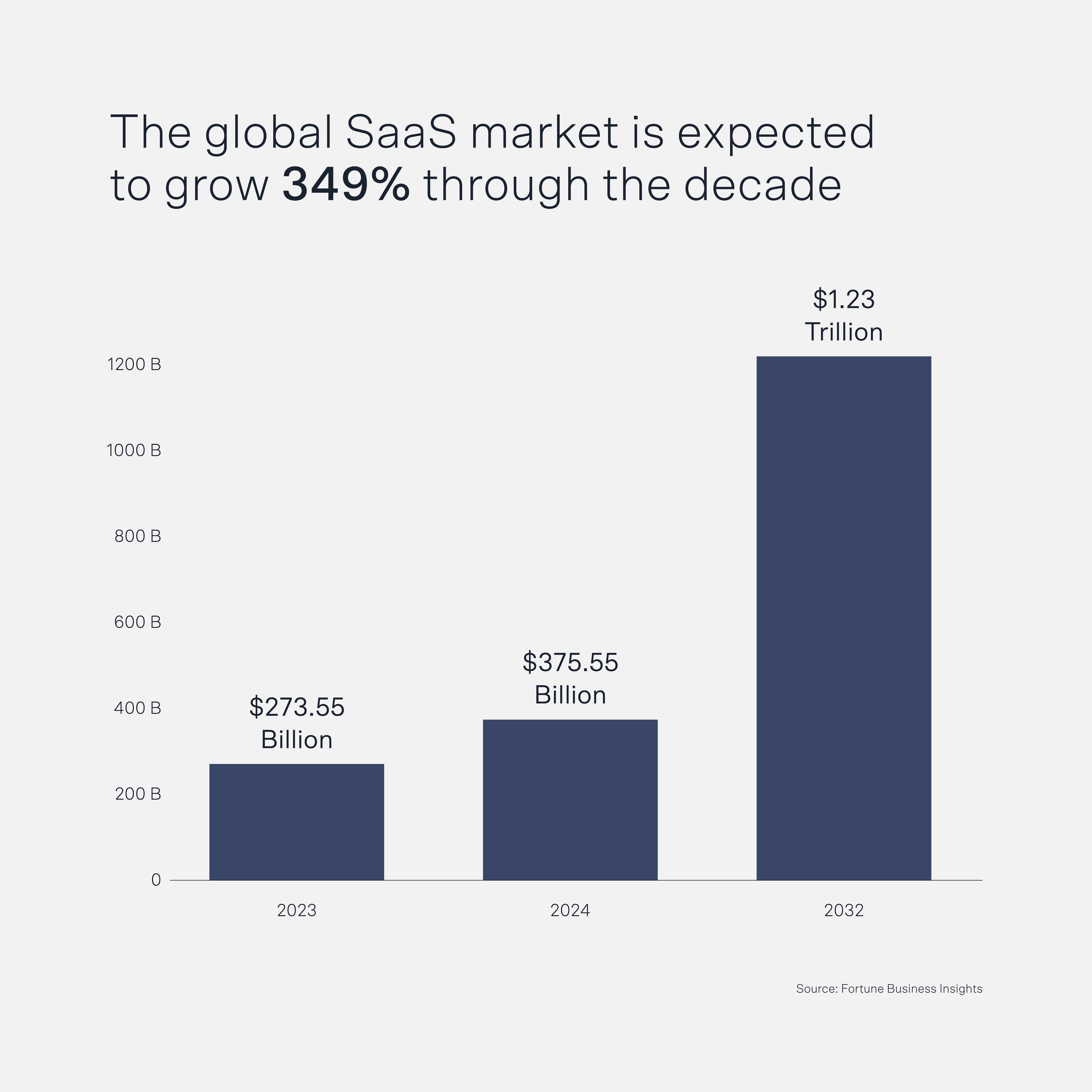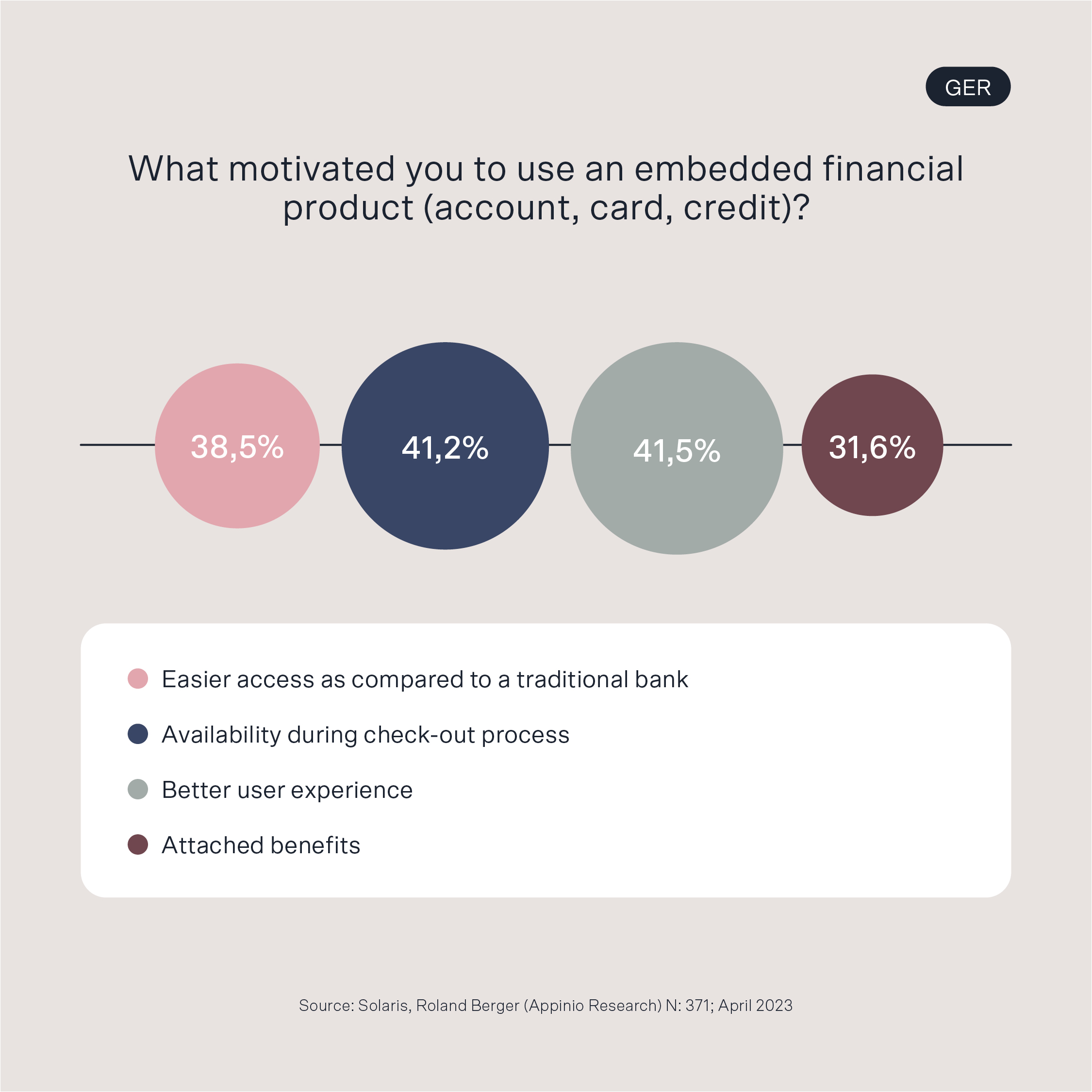How SaaS companies can step up and stand out with embedded finance
5 minute read


With a projected value of $1.2 trillion by 2032 — a compound annual growth rate of 18.4% — the enterprise SaaS industry's future is looking bright.
By the end of 2025, 85% of the technologies businesses rely on for both front-office and back-office operations will be SaaS-based, with the average enterprise already subscribed to around 473 SaaS products.
There's just one catch.
According to Barometrics, the annual churn rate across cohorts — cohorts being SaaS products grouped by approximate revenue per user — averages out at 61%. This is well above the widely accepted industry benchmark of 5%.
As the industry continues to grow, competition will only get stiffer. Which will likely lead to a double-whammy of rising customer acquisition costs and churn rates.

The good news is that it's possible for SaaS companies to not only overcome these challenges, but actively boost revenue and lower churn rates. And that's where embedded finance comes in.
Here's a look at how embedded finance can help SaaS companies build more valuable products that deepen relationships with customers and encourage more of them to stick around.
What's embedded finance?
Before we dive into the benefits of embedded finance and specific use cases, here's a quick refresher on what it is and how it works.
At its most basic, embedded finance products are financial services products that have been seamlessly incorporated into existing user journeys and offered to customers at the point of need.
The SaaS platform owns the product and the relationship with the customer, but doesn't need to obtain a financial services license or pivot part of its operations in order to accommodate this new line of business.
Instead, it makes use of a specialized partner's license, as well as their compliance, risk management, and other back-office capabilities and expertise.
Why incorporate embedded finance into your SaaS platform?
Embedded finance has three key benefits for SaaS platforms:
-
It deepens customer relationships
-
It helps lower churn
-
It's a lucrative source of additional revenue on top of subscription fees
And it achieves all three by enabling you to enhance your product's value through highly-personalized products that complement your core offering.
Say you're a SaaS-based accounting software platform.
At the end of the quarter, a customer's accounting data shows that they have a cash-flow issue, and their reserves may not be enough to pay all the bills coming due.
With embedded finance, you could offer the customer an account with an overdraft facility or other lending solutions they could draw on while they await their receivables.
The customer gains access to a valuable additional service — fast credit at an affordable rate when they need it most — which makes them more likely to stick with your accounting platform long term.
As for the business, since the terms of the customer lending are based on customer data already in its possession, the risk can be kept to a minimum. Any SaaS business also has the opportunity to increase the number of customer touchpoints — no longer serving solely as an accounting software app but also as a lender — while generating additional revenue through interest and fees.
Already have a financial services license?
Partnering with an embedded finance provider may still be worthwhile, because it enables you to branch out into complementary (and lucrative) verticals your current license might not cover.
Say you're an expense management software platform that enables its customers to issue prepaid cards to staff which they can use to pay for travel costs, client entertaining, and other business expenses.
In order to have card-issuing capabilities, you've obtained an e-money license. But while this type of license allows you to issue debit cards and prepaid cards, it specifically precludes you from offering lending products.
By partnering with an embedded finance provider with a full banking license, you could branch out into credit cards or other borrowing products such as business loans, without having to go through the time and cost of acquiring an additional financial services license to cover the new products.
The three most compelling embedded finance use cases for SaaS platforms
So, which embedded finance use cases are best-suited to SaaS platforms?
In our view, the three that would benefit them most are cards, payment flows, and KYC.
Here's a more in-depth look at each product.
Cards
Payment cards are a mainstay of expense management platforms. But they're also a natural fit for HR platforms like Personio and Sage HR, as well as other employee-focused platforms, such as rewards program Perkbox.
Expensing is the most straightforward use case. Instead of having to pay out of pocket and submit expense claims — a process that is not only laborious and inefficient — customers can issue staff with expense cards.
The business customer benefits by streamlining their admin and gaining more visibility into company-wide spending, allowing them to budget and forecast more accurately, as well as curb spending abuse by individuals.
As a platform, you earn revenue from each transaction — Solaris' model, for instance, means you earn a share of the interchange fees — and gain access to a wealth of data about your customers and their staff's spending patterns which you can use to enhance your platform and offer more tailored products.
But cards — and accounts — also have other compelling use cases, such as salary advances, cashback, and rewards.
These use cases create a closed loop — your business customers and, in turn, their employees, are encouraged to use their cards more, which in turn gives you access to more data and boosts fee revenue.

Payment flows
Slow payment processing times are a significant pain point for many businesses. In Germany, for instance, only around 2.5% of electronic payments are processed in real time. And the country is the European leader in real-time payments.
These delays, even if it's just a few hours, cause all sorts of operational issues, from accidentally double-billing customers to inaccurate budgeting and forecasting, needless admin, and more risk.
Real-time money-movement products like Solaris' Payment Flows solve these issues by giving customers more flexibility when it comes to both getting paid and making payouts, and processing data instantly so that financial records are always up to date.
They're an especially compelling use case for enterprise resource planning (ERP) software platforms like Oracle, because real-time processing ensures budgeting and forecasting are always based on hard data instead of potentially imprecise projections.
But the reduction in manual work, faster pay-ins and payouts, and real-time visibility make it a compelling proposition not just for ERP and accounting software providers, but for expense management platforms, ecommerce platforms, and other employee-facing or customer-facing software, too.
KYC & KYB
Onboarding is an essential step, especially for SaaS platforms that work in highly regulated environments like financial services or healthcare, but the process is often a major friction point.
In Precursive's latest onboarding report, for instance, a poor onboarding experience was the third biggest contributor to customer churn, after poor fit and lack of engagement.
A good onboarding experience, on the other hand, has the opposite effect. In a Wyzowl study, 86% of respondents said they're more likely to be loyal if the onboarding process is quick and easy.
Embedded KYC products such as video identification, digital screening, and e-signature can streamline and simplify the process dramatically, without compromising on security or falling foul of compliance obligations.
Solaris' business KYC, for instance, makes it possible to complete SME and enterprise clients' onboarding in less than 48 hours.
Opportunity awaits… but only if you seize the initiative
Boosting customer retention is the most cost-effective strategy in any industry.
But, in a highly competitive market like enterprise B2B SaaS, where customer acquisition costs can reach $5,000 to $15,000, the difference to your bottom line can be even more pronounced.
Needless to say, the key to greater retention is customer satisfaction. The more valuable your product is to your clients, and the more central it is to their operations, the more likely they'll be to stick around.
With embedded finance, you can make sure that the value-add is always tailor-made to individual clients' changing circumstances. And what could be more valuable to a business than the exact support they need, at the exact moment they need it?